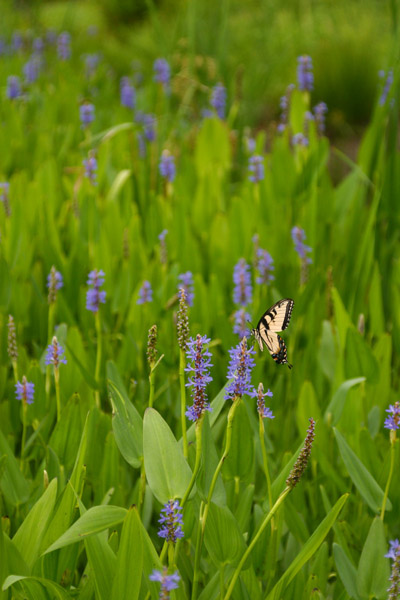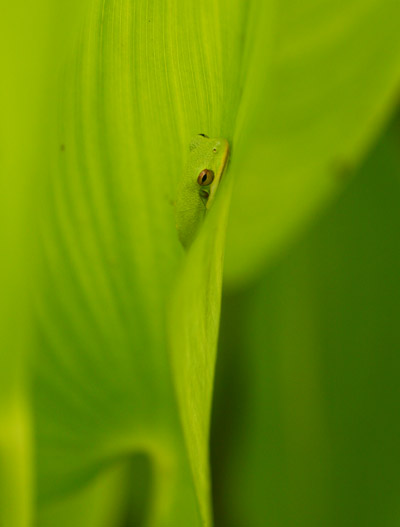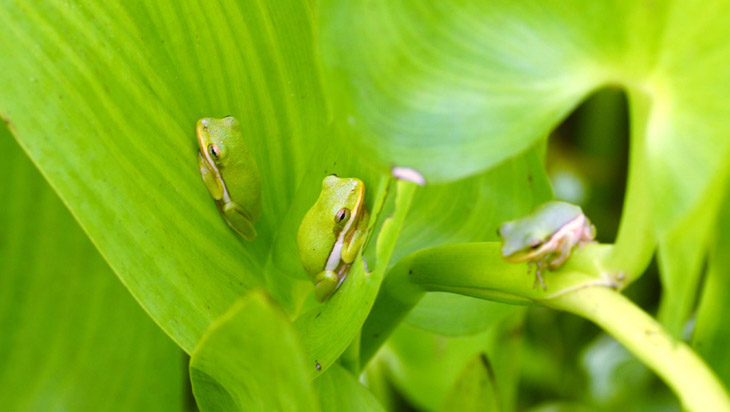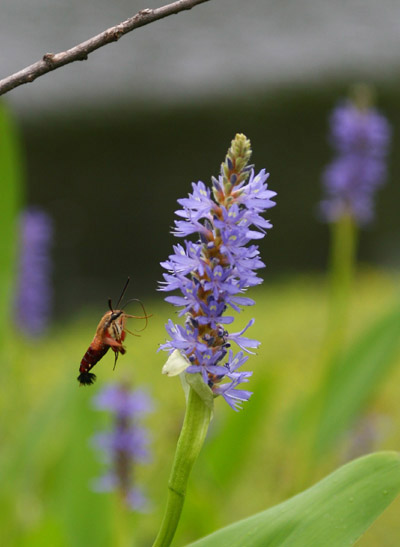 Our attempts to catch up continue, as we hearken back to six days ago and a visit to a nearby pond. A variation of this view was seen earlier, but I also like this version for the additional isolation. The pickerelweed plants seem to stretch for a significant distance, accentuating the idea that the eastern tiger swallowtail (Papilio glaucus) is all alone, but if you look close you can see that the patch stops towards the top of the frame. In reality, it was roughly eight meters long and perhaps half that wide – somewhere around the size of two cars end-to-end, not something one could get lost within even if they were short enough not to see over the tops. And while the swallowtail was far from the only pollinator attacking those flowers (as proven by the earlier photo,) it was the only one visible in this frame. I actually stalked the butterfly for a short distance, trying to capture the wings at the right angle as it rapidly circled the blossom clusters taking the minimal nectar available. This was made more interesting by the fact that I was semi-wading at the time, not-quite ankle deep in cloying mud that was doing its best to suck the sandals off my feet. Step too lively in conditions like that and you’re going down, as your feet refuse to move in time to arrest your forward momentum.
Our attempts to catch up continue, as we hearken back to six days ago and a visit to a nearby pond. A variation of this view was seen earlier, but I also like this version for the additional isolation. The pickerelweed plants seem to stretch for a significant distance, accentuating the idea that the eastern tiger swallowtail (Papilio glaucus) is all alone, but if you look close you can see that the patch stops towards the top of the frame. In reality, it was roughly eight meters long and perhaps half that wide – somewhere around the size of two cars end-to-end, not something one could get lost within even if they were short enough not to see over the tops. And while the swallowtail was far from the only pollinator attacking those flowers (as proven by the earlier photo,) it was the only one visible in this frame. I actually stalked the butterfly for a short distance, trying to capture the wings at the right angle as it rapidly circled the blossom clusters taking the minimal nectar available. This was made more interesting by the fact that I was semi-wading at the time, not-quite ankle deep in cloying mud that was doing its best to suck the sandals off my feet. Step too lively in conditions like that and you’re going down, as your feet refuse to move in time to arrest your forward momentum.
What I was really after with this brief trip, however, were green treefrogs. The night had been cool and damper than usual, a nice break from the long periods of heat and dry conditions that we’ve been having, and the morning was overcast – the frogs, which are primarily nocturnal, can cope with this much better than with bright sunlight, since they have to remain moist. So misty, cool, or damp mornings provide the opportunity to see them before they seek deep shelter from the day’s heat, and the pickerelweed plants are a favorite hangout, as I found out last year. But for a while, I was finding nothing, both curious and frustrating. Then I spotted a subtle telltale.
 The light was just barely bright enough to shine through the broad leaves, and this suspicious little oval shadow is something that I’ve seen before. Only about the size of the top joint of your thumb, it was the right size and the right shape for a typical position of a treefrog, since they often sit with their legs tucked tightly in, much like cats. This was deep in a thick patch of the water plants, however, and while I could manage a decent view from this side, the other side was going to prove difficult.
The light was just barely bright enough to shine through the broad leaves, and this suspicious little oval shadow is something that I’ve seen before. Only about the size of the top joint of your thumb, it was the right size and the right shape for a typical position of a treefrog, since they often sit with their legs tucked tightly in, much like cats. This was deep in a thick patch of the water plants, however, and while I could manage a decent view from this side, the other side was going to prove difficult.
While we wait for Past Me to make his way over there, I will speculate on this trait. The frogs match this coloration fairly well, so just about any place on the plant is camouflage enough, but there are likely a couple of reasons why this position is preferred. The first is that it sits in a slight fold of the leaf, so any dew or rain is channeled directly to them. The leaf is also strongest near the stem, so less chance of it either drooping over or the frog having to vault off from an unstable surface when trying to escape something. And finally, their arch enemy is the green heron, but up on the middle part of the leaf like this, the frogs are farthest from any surface that will support the small wading bird, so least likely to be eaten there. I can presently confirm none of this, so don’t go confidently repeating it to your class or anything.
 In time, I managed to get to a position that was just barely adequate, seeing through a gap in the surrounding plants right along the edge of the leaf, but enough to reveal that the source of the shadow was exactly as suspected. I told you the color was a close match. This green treefrog (Hyla cinerea) was about half of adult size, being less than 3 cm in body length. I wanted to work with the lower contrast and specific colors of natural light, so I left the flash in the bag, but the overcast conditions meant I was once again shooting mostly at largest aperture (f4 in this case, the wonderful Mamiya 80mm macro that fits on my Canon cameras with a custom mount.) This had the effect that, with the short focus, the frog almost seems to blur into the leaf itself. I might have to do some more experiments with short depth-of-field in these situations…
In time, I managed to get to a position that was just barely adequate, seeing through a gap in the surrounding plants right along the edge of the leaf, but enough to reveal that the source of the shadow was exactly as suspected. I told you the color was a close match. This green treefrog (Hyla cinerea) was about half of adult size, being less than 3 cm in body length. I wanted to work with the lower contrast and specific colors of natural light, so I left the flash in the bag, but the overcast conditions meant I was once again shooting mostly at largest aperture (f4 in this case, the wonderful Mamiya 80mm macro that fits on my Canon cameras with a custom mount.) This had the effect that, with the short focus, the frog almost seems to blur into the leaf itself. I might have to do some more experiments with short depth-of-field in these situations…
Once I found the first, I began spotting others, though I noticed that overall, they concentrated in one area of the pickerelweed and not, of course, the area that I’d begun in. What prompted this differentiation I cannot tell because I’m sworn to secrecy because I haven’t the faintest idea. All areas seemed identical to me, and the separation wasn’t that great at all, but I am not a treefrog. The difference was noticeable enough, however, when I soon found three clustered remarkably close together.

I did a lot of playing, trying to get all three in the same plane of focus or, alternately, to stop down enough that the depth covered them adequately, but it simply wasn’t happening – in this frame I focused on the two closest together. It’s easy to see that all three are on their own leaves or stalks, and this is typical too; whether this is a territorial thing, maintaining their own feeding grounds, or simply not to overburden their perches is all open for speculation. The one on the right is well aware of my presence and warily perched to make an escape, though it soon relaxed when I held still long enough. Notice that it is slightly darker in shade than the others, not blending in quite as well as My Cousin Vinny, and this is a variation I’ve seen a lot – it’s an integrated neighborhood.
 While all of this was going on, I was often in the middle of bumblebees feeding from the flowers, and what I suspect was a solitary clearwing moth, seen several times over. I did not get a close enough image to pin down the exact species (the color of the legs is the key trait,) but I think it was Hemaris thysbe – certainly genus Hemaris, anyway. They’re fun insects to watch, but hyperactive enough to make good photos challenging, not helped at all by the fact that they never land when feeding, instead hovering at the flowers like the hummingbirds that they often mimic. They also mimic bumblebees, and this trait is enough to distinguish them easily because bumblebees always land on the flowers.
While all of this was going on, I was often in the middle of bumblebees feeding from the flowers, and what I suspect was a solitary clearwing moth, seen several times over. I did not get a close enough image to pin down the exact species (the color of the legs is the key trait,) but I think it was Hemaris thysbe – certainly genus Hemaris, anyway. They’re fun insects to watch, but hyperactive enough to make good photos challenging, not helped at all by the fact that they never land when feeding, instead hovering at the flowers like the hummingbirds that they often mimic. They also mimic bumblebees, and this trait is enough to distinguish them easily because bumblebees always land on the flowers.
[I’m still undecided on this crop, because I don’t like that distinctive disembodied branch in there, but cropping it out would have meant cutting off or too close to the background flower on the right, which I think balances the frame – overall I like the placement of the four blossom spikes. I suppose I could just ‘shop the damn thing out…]
 And finally, the last frog captured that morning, in a session that lasted all of fifteen minutes – I just stopped briefly to check on things while running other errands. Yes, this was the last stop before returning home with my filthy feet – I have a little decorum left, and won’t go to public places looking like some derelict. Or even more so than necessary, anyway.
And finally, the last frog captured that morning, in a session that lasted all of fifteen minutes – I just stopped briefly to check on things while running other errands. Yes, this was the last stop before returning home with my filthy feet – I have a little decorum left, and won’t go to public places looking like some derelict. Or even more so than necessary, anyway.
This one I had missed until it hopped away at my approach, clinging to a stalk with those wonderfully sticky toe pads they have, but moving slowly thereafter, I was able to close in for some tight shots without spooking it away again. That background is wonderfully vague.
For a long time, this was the only really decent photo of a green treefrog that I had, since I simply wasn’t finding many, and when I did I couldn’t achieve a superior frame. But like many shots I once treasured, I eventually surpassed it, mostly with last year’s crop, and it’s nice to have images that aren’t of captives. The photo stock expands, the selection improves, the favorites get replaced; that’s how it should be. Now, is it happening as fast or as dramatically as it should be? That’s a different question altogether…




















































